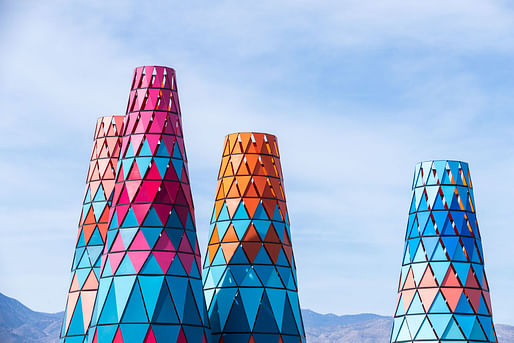
Diébédo Francis Kéré has been awarded the 2022 Pritzker Architecture Prize, widely considered one of the industry's highest honors.
"Francis Kéré has found brilliant, inspiring and game-changing ways to answer these questions over the last decades," said the jury citation for the award. "His cultural sensitivity not only delivers social and environmental justice, but guides his entire process, in the awareness that it is the path towards the legitimacy of a building in a community. He knows, from within, that architecture is not about the object but the objective; not the product, but the process."

Born in Gando, Burkina Faso in 1965, Kéré studied architecture at the Technical University of Berlin. In 2005, while living in Berlin, he set up Kéré Architecture and has since designed a portfolio of notable works, including the 2017 Serpentine Pavilion, installations at Coachella, and a pavilion for the Tippet Rise Art Center fashioned from a collection of tree trunks.
"I grew up in a community where there was no kindergarten, but where community was your family," said Kéré upon the award's announcement. "Everyone took care of you and the entire village was your playground. My days were filled with securing food and water, but also simply being together, talking together, building houses together. I remember the room where my grandmother would sit and tell stories with a little light, while we would huddle close to each other and her voice inside the room enclosed us, summoning us to come closer and form a safe place. This was my first sense of architecture."

Kéré's vocation to become an architect stems from a personal commitment to serve the community he grew up in and a belief in the transformative potential of beauty. He is known for his socially-driven approach to architecture and his innovative construction strategies that combine modern engineering with traditional building techniques, particularly in regards to his projects in his home country of Burkina Faso.
"Francis Kéré’s entire body of work shows us the power of materiality rooted in place," the citation continues. "His buildings, for and with communities, are directly of those communities — in their making, their materials, their programs and their unique characters. They are tied to the ground on which they sit and to the people who sit within them. They have presence without pretense and an impact shaped by grace."
Kéré has held professorships at the Harvard Graduate School of Design, Yale School of Architecture, and the Swiss Accademia di Architettura di Mendrisio. Among his many accolades are the 2004 Aga Khan Award for Architecture, the 2017 Brunner Prize at the American Academy of Arts and Letters, and the 2021 Thomas Jefferson Medal in Architecture.
Kéré will join the Pritzker's honorary list of laureates, which in recent years included Anne Lacaton and Jean-Philippe Vassal of Lacaton and Vassal (who collectively won the 2021 prize), Yvonne Farrell and Shelley McNamara of Grafton Architects (who collectively won the 2020 prize), Arata Isozaki (2019), Balkrishna Doshi (2018), RCR Arquitectes co-founders Rafael Aranda, Carme Pigem, and Ramon Vilalta (2017), Alejandro Aravena (2016), the late Frei Otto (2015), Shigeru Ban (2014), Toyo Ito (2013), and Wang Shu (2012).
6 Comments
Wonderful work. Mysterious and beautiful.
+++++
Add this:
Startup Lions Campus, 2021, Kenya
The campus was built for the non-profit organisation Learning Lions to offer young Kenyans free training in information and communication technologies.
https://www.dezeen.com/2022/03...
Great work. Well deserved
Brilliant! More!
Nicolás Valencia's piece is quite good:
https://www.archdaily.com/9787...
Speaking of his first project, a school:
In this project, Kéré, as seen in his subsequent projects built in West Africa, understands that his design is the result of combining basic needs, limited budgets, convincing communities to work as a team, and a low-tech definition of sustainability based on revaluing and adapt the vernacular techniques of the community for their own benefit. Of course, without sacrificing the beauty of architecture.
On top of what he brings to Kenya, we should think about what can be learned from his work. Basic needs, sustainability, limited budgets, a sense of place and people—these apply everywhere in varying ways and degrees.
In Kéré's works, nothing is superfluous, but that doesn't mean that he rules out from the equation the good design that thrills us. He thus achieves a delicate balance between the reformulation of local techniques and outstanding design, avoiding the romanticization of precariousness.
But I most like his work because it is substantial and expressive. My reaction was immediate and hasn't faded. Architecture has been talking to itself too much at our expense and is running out of ideas. It needs fresh input.
Block this user
Are you sure you want to block this user and hide all related comments throughout the site?
Archinect
This is your first comment on Archinect. Your comment will be visible once approved.